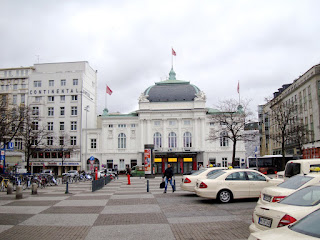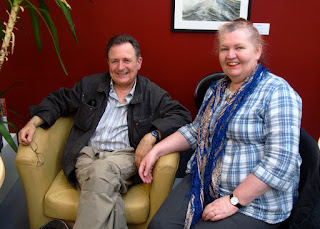The Alster - on a November day in March
ROBINSON’S GERMAN JOURNEY: DAY NINE / PART ONE
THURSDAY 29 MARCH 2012
HAMBURG
There are many elements that contribute to the overall sense of excitement and adventure on a trip like this one; but packing isn’t one of them. To me, it is - and always has been - a regrettable necessity, like power stations or by-passes. If you’re leaving home for any length of time, you just have to take clean underwear, a toothbrush, a few shirts and socks, travel tickets and passport - and so on and so on and so on…
Merely packing whatever comes to hand simply isn’t good enough. I once took a lovely, warm, woollen fleece jacket to Crete. I arrived on Corfu with many pairs of good, thick, winter socks. For a narrowboat holiday I once packed four towels and no shirts at all.
And you have to take things in the right quantities. Stuffing your suitcase with four extra pairs of shoes without leaving room for some soap or your camera is almost a definition of stupidity, or at least a profound lack of forethought.
I know what the answer is, of course. You have to make a list. So I do. And I put on my list all the things I know I will need - see above - and then I add to the list all the paraphernalia I won’t be able to enjoy my trip without. And, thanks to the digital revolution, this supplementary part of my list can itself be quite extensive.
I can now take my laptop computer with me wherever I go, even though it weighs the same as a small car and needs its charger and a USB stick (don’t ask) as well.
The digital camera will need its charger, too - and the cord that connects it to the laptop so I can download the pictures I’ve taken instead of spending time outside in the city I’m visiting.
The iPhone must also be accompanied by such a cord and - needless to say - yet another charger.
And all this equipment will still be unusable if I forget to pack continental plug adaptors. (I know I’m not the first person in history to wonder why we can’t all use the same plugs and sockets but that doesn’t stop me wondering it.)
Having written my list, I do what everyone else seems to do; I lay it all out on the bed next to my empty suitcase and burst into a mixture of tears and laughter (like you do when you think of Ed Miliband or Piers Morgan). I’ve known several people who could furnish a small flat with what they can get inside a suitcase. Things like socks and t-shirts seem to vanish completely into a black hole, thus leaving plenty of room for the fridge-freezer, a medium-sized bookshelf and the cat.
This is no joke. A friend of mine once offered to show me how it’s done. We laid all my essentials out on the bed as per, and she packed my case for me. When she’d finished, there was still enough room in the case for a lawn-mower. She then unpacked it and invited me to re-pack. When I’d finished, I was two shirts and four pairs of socks adrift - and I’d lost my list.
Sad to say, this aspect of going away on holiday has never changed, except perhaps that I’ve become a little more judicious in my choice of holiday apparel. Gone are the days of collapsible umbrellas to the Greek Islands or measly, thin cotton shorts to Mull or Skye.
For my German journey, I had decided that the only outer layer I could ever conceivably need was a kind of thin, semi-lined gilet - or ‘body warmer‘ - which I’d bought, and which had been perfectly adequate, for my Grand Tour to Italy. Exactly how injudicious a choice this was became apparent as soon as I stepped outside my hotel in Hamburg and into what seemed to be an icy Thursday inside the Arctic circle.
The city of Hamburg lies where the River Elbe begins to broaden into an estuary and flow north-westwards to the North Sea. Coming in the opposite direction - even, I’m told, in the height of summer - are the blusteriest, most unpredictable and numbingly cold winds imaginable in the ‘temperate zone’. It feels as if they mustered, like malicious, screeching demons, somewhere near Spitzbergen, cast a last affectionate glance down at all the walruses and polar bears, and headed straight for Hamburg.
They are what my Nana used to call ‘idle winds’; too lazy to blow around you so they blow straight through you. As soon as the hotel door slammed shut behind me, I was - as she also used to say - nithered. It felt as if I’d been body-slapped by a shoal of recently-caught Norway cod. As I walked toward the Alster - Hamburg’s inland lake - I felt positively cryogenic.
This was Messingaffenwetter (look it up) with a vengeance.
Across the Alster
I decided that, for the moment at least, my Hamburg guidebook could go to the devil. As scenic an asset as the Alster undoubtedly is, I couldn’t really see it anyway. My eyes were half-closed against the blast - and it had started to rain. And this was no ordinary rain, either. This wasn’t a friendly, late Spring shower giving the daffodils a gentle, refreshing soak. This was Hamburg rain hitting my glasses (and the rest of me). It was several degrees colder than charity (Nana again) and hurled itself at me horizontally at 100mph.
Naturally, this was the first day of my holiday on which I’d decided to wear shorts. Some people are beyond help or even pity.
I decided that, as I was in Hamburg, I should do what Hamburgers do. Have a Hamburger.
--------------------------------------------
While I was dodging the onslaught of rain and gales, and failing to find a genuine Hamburg hamburger, I began to wonder if German tourists in, say, Bath would find it this hard to find a Bath Bun. Were there hungry foreign gourmands in Eccles or Chorley or Bakewell or Banbury in the same predicament as me.
Cornish pasties, Yorkshire Puddings, Cumberland sausage - all were freely available in the places of their birth. So where were all the bloody hamburgers?
I sheltered as best I could in a ‘smokers’ doorway’, which I shared with a ground-level statue of Heidi Kabel. She was an immensely popular actress, born and bred in Hamburg, who'd died in 2010. Even she seemed to be shivering.
Heidi
I whipped out my trusty Oxford German Mini-Dictionary and, after a moment’s brief translation work, decided to ask the office-worker next to me ‘Wo kann ich ein Hamburger geniessen?’ His reaction was to cough and splutter his cigarette fumes all over passers-by. I had just asked him where I could enjoy a Hamburger and hadn’t realised it was quite so open to misinterpretation.
The national theatre in Hamburg; it's opposite the station
Hamburgers have something of a sad history. They started life here as good, wholesome (if stodgy) ‘peasant’ food. German emigrants took them to the USA, where they have become the absurdities they are today.
The word itself has suffered, too. Hamburgers contain no ham so our inventive American cousins re-christened them ‘beefburgers’, just to make things clearer - and losing the link to the city of their origin, which was not (after all) Beefburg.
This in turn gave rise to cheeseburgers, baconburgers, chickenburgers and even fishburgers. Nowadays, the word ‘burger’ can be heard and seen in everyday use.
Hamburg has a lot to answer for.
My fellow-shelterer asked me - in English - why I wanted one of those (said with a sneer). They were, he said, working-class food - meatballs in bread. But I persisted, telling him that I was on a special, place-name food tour and that I’d already eaten a frankfurter in Frankfurt.
Despite the prevailing meteorological conditions, he managed to smile sarcastically, recognising a blatant lie for what it was and said ‘You English!‘ He pointed me in the direction of the station and told me that I could enjoy as many hamburgers there as I liked, because the very, very best hamburger bar in Hamburg was in the station.
The station's clock tower
And he was right; it was.
--------------------------------------------
CONTACT ME
Post comments on this blog or email me: truckshunters@googlemail.com














































